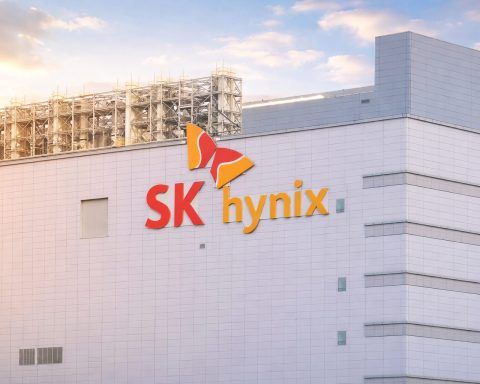- Nintendo Switch 2: Borderlands 4 will launch on the Switch 2 on October 3, 2025, according to Gearbox CEO Randy Pitchford, with the Switch version running about 30fps to preserve feature parity.
- Google Pixel 10 Pro: Google released a Pixel 10 Pro teaser ahead of its August 21, 2025 launch, showing an evolutionary design and promising upgrades including improved camera capabilities and Android 16 integration.
- Chip tariffs affect TI: Texas Instruments warned new U.S. tariffs could dent demand, issuing a softer sales forecast and sending its stock down about 12%.
- TSMC profit with caution: TSMC posted a 60% year-on-year surge in quarterly profit fueled by AI-chip demand, but cautioned that export tariffs and a stronger Taiwan dollar could impact the long-term outlook.
- América Móvil Q2 results: América Móvil reported a Q2 profit of $1.19 billion, aided by foreign exchange gains and the addition of nearly 3 million postpaid subscribers across its markets.
- SharePoint zero-day: A previously unknown SharePoint zero-day was exploited, compromising about 100 organizations worldwide before patches were released and CISA issued urgent directives.
- Iranian spyware alerts: Apple notified Iranian activists that their iPhones were hacked by state-sponsored spyware in at least three waves documented by the Miaan Group, with targets in more than 150 countries.
- Meta Threads monetization shakeup: Meta ended the Threads monetization bonus program on July 22, 2025, as Threads surpassed 200 million sign-ups and the company pivots toward direct messaging and fediverse integration.
- TRACERS launch and mission: NASA’s TRACERS mission launched on July 23, 2025 aboard a SpaceX Falcon 9 from California, with the booster landing on a drone ship and a two-year polar-orbit study of geomagnetic activity.
- Stellantis Leapmotor Africa deal: Stellantis will begin selling Leapmotor C10 in South Africa starting September 2025 after a $1.6 billion stake in Leapmotor, with local assembly planned to reach 100,000 vehicles per year by 2030.
Consumer Electronics & Gaming
Nintendo’s Next-Gen Console Hinted: The successor to Nintendo’s Switch console (“Switch 2”) effectively broke cover as Gearbox CEO Randy Pitchford revealed Borderlands 4 will launch on the new system on October 3, 2025 Nintendolife – just three weeks after its debut on other platforms. The announcement, made via Pitchford’s social media video, confirms that Nintendo’s long-rumored next-gen hardware will be in players’ hands by early October. The Switch 2 version of Borderlands 4 will run “mostly around 30fps” to maintain full feature parity and cross-play, according to Pitchford, who emphasized, “It was important to us to not cut anything” for the Switch audience Nintendolife.
Google Teases Pixel 10 Pro: Google offered an early peek at its upcoming flagship smartphone. A teaser released for the Pixel 10 Pro – slated for an August 21 launch – shows a design that is evolutionary rather than radical, while promising an array of new features and upgrades Indianexpress. The Pixel 10 Pro is expected to refine Google’s hardware formula with improved camera capabilities and seamless integration of Android 16 (without divulging specifics yet). Industry observers note that Google’s teaser aims to drum up excitement in a competitive premium phone market heading into the fall launch season.
Hardware & Semiconductors
Chip Demand Meets Tariff Jitters: Even as global chipmakers report strong demand, trade tensions are injecting caution. Texas Instruments (TI) warned that new U.S. tariffs could be denting customer demand, issuing a softer sales forecast that sent its stock down 12% Reuters. TI CEO Haviv Ilan told analysts he “can’t rule out the possibility” that tariff concerns are prompting customers to advance orders, and analysts noted the company’s tone has “shifted markedly” with more caution around the geopolitical and tariff environment Reuters. The sentiment is industry-wide – ASML and TSMC both flagged tariff-related uncertainty in recent days Reuters. Notably, TSMC had just posted a record quarterly profit (a 60% year-on-year surge) fueled by booming AI-chip demand, but its CEO C.C. Wei cautioned that looming U.S. chip export tariffs and a stronger Taiwan dollar could “impact…so we are becoming more conservative” on longer-term outlook Reuters.
Foreign Exchange Boosts Telecom Giant: In telecommunications hardware, Latin America’s biggest carrier América Móvil reported a surprise second-quarter profit of $1.19 billion after a loss a year ago Reuters Reuters. The Mexican telecom giant – controlled by Carlos Slim – credited hefty foreign exchange gains for the swing, as U.S. trade measures indirectly weakened the dollar against Latin American currencies, cutting financing costs Reuters. The carrier also added nearly 3 million postpaid mobile subscribers across its markets, signaling resilient user growth even amid intense competition on its home turf.
Cybersecurity
Microsoft Software Zero-Day Exploited: A sweeping cyber-espionage campaign exploiting a previously unknown flaw in Microsoft’s SharePoint server software came to light, compromising about 100 organizations across the U.S., Europe and beyond Reuters Reuters. Security researchers revealed hackers (suspected “China-nexus” actors) have been actively leveraging this zero-day since early July, inserting backdoors into vulnerable servers. “It’s unambiguous… Who knows what other adversaries have done since to place other backdoors,” warned Vaisha Bernard, chief hacker at Eye Security, whose team first identified the breach Reuters. Microsoft rushed out patches and “provided security updates and encourages customers to install them,” a company spokesperson said in a statement Reuters. With thousands of servers potentially exposed, cybersecurity agencies like CISA issued urgent directives to apply fixes amid fears of broader fallout. Analysts note the incident underscores growing enterprise risks from neglected on-premise software, and comes on the heels of high-profile breaches of cloud email systems earlier in the year.
Spyware Targeting Activists: Meanwhile, a disturbing digital espionage campaign targeted civil society in the Middle East. Apple quietly notified dozens of Iranian activists and dissidents that their iPhones were hacked by state-sponsored spyware Techcrunch. A new report by the Miaan Group documents at least three waves of covert surveillance attacks likely orchestrated by Iran’s government. “Many members of their family have been executed… We have only seen the tip of the iceberg,” said Amir Rashidi, Miaan’s digital security director, emphasizing the gravity of the threat Techcrunch. Researchers have not yet identified which commercial spyware (such as NSO’s Pegasus or a similar tool) was used, but Apple’s threat notifications since 2021 span targets in over 150 countries Techcrunch. Digital rights advocates applauded Apple’s alerts and urged at-risk users to enable lockdown mode and seek support from organizations like Access Now Techcrunch Techcrunch. The revelations highlight the continued proliferation of “mercenary” spyware and its use against journalists and activists, even as governments face pressure to curb the abuse of these cyber weapons.
Software & Social Platforms
Meta’s Threads Shifts Tactics: Meta made waves in the social media arena by ending the monetization bonus program for its new Threads platform. The company had been paying select creators to boost engagement after Threads’ launch as a Twitter/X alternative, but on July 22 it quietly halted those bonus payouts Engadget. (Meta is still pushing to attract users to Threads – which crossed 200 million sign-ups – but is pivoting away from direct payments to encourage content creation.) The move suggests Meta will focus on long-term feature development and integration with the Fediverse rather than short-term growth hacks. “Two years later, Meta is making DMs on Threads official,” noted Engadget, pointing out that the company is instead rolling out new features like direct messaging and fediverse support to sustain user interest Indianexpress Techmeme. Creators expressed disappointment at the sudden bonus program cutoff, but Meta’s strategy reflects the challenges of maintaining momentum on the fledgling platform without continually shelling out incentives.
Enterprise Software Updates: In enterprise software news, SAP and Salesforce both issued mid-year updates to their platforms (focusing on workflow automation and CRM enhancements, respectively), though without any AI tie-ins this cycle. Microsoft, for its part, rolled out its July feature update for Windows 11, bringing quality-of-life improvements and dozens of security patches addressing vulnerabilities like the one exploited in the SharePoint attacks. And in the Apple ecosystem, developers received iOS 16.6 and macOS 13.5 releases on July 23 – primarily security fixes to shore up Apple devices against the very spyware threats making headlines Techcrunch. While these software updates lack splashy consumer features, they underscore a broader industry shift this month toward hardening software security and reliability.
Biotech & Health Tech
FDA Gets Tough on Biotech: In a signal of more stringent U.S. regulatory scrutiny, the FDA rejected a cutting-edge skin cancer therapy developed by Replimune on July 22. The immunotherapy, called RP1, had shown promise for advanced melanoma, but regulators issued a surprise complete response letter citing that the single-arm Phase 2 trial was “not considered to be an adequate and well-controlled” study demonstrating effectiveness Biopharmadive. Replimune’s CEO Sushil Patel said the company was “surprised” by the decision, noting FDA hadn’t raised these trial design issues in earlier meetings Biopharmadive. The news sent Replimune shares tumbling and sparked debate in biotech circles about the FDA’s evolving standards. “It is obvious [Replimune] got caught in a changing FDA regulatory landscape,” observed Cantor Fitzgerald analyst Li Watsek in a note to clients, suggesting the agency under new leadership is raising the bar for novel gene and cell therapies Biopharmadive. This tougher stance was further evidenced by the FDA delaying or denying several high-profile drug approvals in recent weeks, emphasizing demand for more rigorous, controlled evidence.
Investment and M&A Highlights: Despite regulatory hurdles, biotech investment continues. Boston-based Omega Funds announced it has raised a fresh $647 million fund to back life sciences startups in the U.S. and Europe Biopharmadive, exceeding its target amid strong LP interest in health tech. On the M&A front, cancer drug developer iTeos Therapeutics unveiled a plan to liquidate via a $100M asset sale to Concentra Biosciences Biopharmadive – part of a trend of cash-strapped biotechs opting to wind down and return capital. Meanwhile, Roche reported mixed trial results for a novel COPD drug and is mulling next steps Biopharmadive. And in health tech, medtech startups showcased innovations at the July 23 Wearable Tech Conference in Berlin, including next-gen glucose monitors and AI-assisted MRI imaging software (highlighting how biotech and tech are converging to transform patient care).
Space & Aerospace Technology
NASA’s Magnetosphere Mission Launches: An important scientific mission is now on its way to orbit after some last-minute drama. NASA’s TRACERS mission – twin satellites designed to study how Earth’s magnetic field interacts with solar wind – finally lifted off aboard a SpaceX Falcon 9 from California on July 23. The launch came a day later than planned, after the original July 22 attempt was scrubbed due to unexpected FAA airspace restrictions that created a no-go for launch Nasa. Following the 24-hour delay, SpaceX successfully launched at 2:13 pm EDT Wednesday and even landed the Falcon 9’s booster on a drone ship, marking the company’s 89th flight of the year Space Space. TRACERS (Tandem Reconnection and Cusp Electrodynamics Reconnaissance Satellites) will fly in a polar orbit to measure how magnetic explosions funnel solar particles into Earth’s atmosphere Nasa. NASA officials highlighted the mission’s role in understanding space weather that can disrupt satellites and power grids. Along for the ride were three small tech-demo satellites, including Athena (to test quick deployment of Earth sensors) and PExT (a “ roaming” communications terminal) Nasa. The successful launch is a relief for NASA, after the brief delay due to air-traffic safety, and kicks off TRACERS’ two-year mission to unlock geomagnetic secrets.
Private Sector Satellite Milestones: In other space news, SpaceX notched a commercial victory, lofting two powerful internet satellites for client SES on July 22 Space. A Falcon 9 from Cape Canaveral carried SES’s latest O3b mPOWER satellites toward medium Earth orbit to expand high-speed broadband coverage Space. The booster – on its sixth flight – returned for a pinpoint landing at sea Space. This launch underscores the growing role of space-based internet infrastructure, coming just as rival OneWeb nears completion of its LEO constellation. Meanwhile, Boeing’s Starliner crew capsule faced further delays (with NASA pushing its crewed test flight into 2026 due to ongoing safety fixes), and China’s space agency teased a November launch window for its Chang’e-8 lunar mission. Back on Earth, the Paris Air Show wrapped up July 23 with massive orders for Airbus and Boeing planes, signaling confidence in aviation’s post-pandemic rebound. And on the regulatory front, the U.S. FCC approved Amazon’s updated orbital debris plan for its Project Kuiper megaconstellation, clearing a hurdle as Amazon races to deploy satellites to compete with SpaceX Starlink. All told, the past 48 hours saw orbit and aerospace news reach escape velocity – from scientific probes safeguarding our planet to industry giants advancing global connectivity.
Automotive & Electric Vehicles
China’s BYD Rethinks Europe Strategy: A Reuters exclusive revealed that BYD, the world’s #1 EV maker, will delay mass production at its new Hungary factory until 2026, and even then operate far below its 150,000-car annual capacity Reuters Reuters. Instead, BYD is accelerating plans at a lower-cost plant in Turkey, which will start making EVs earlier than expected and in far greater numbers Reuters Reuters. The reshuffle is a setback for the EU’s ambitions – Brussels had hoped that hefty anti-subsidy tariffs on Chinese EV imports (27% in BYD’s case) would spur firms like BYD to build more cars in Europe Reuters Reuters. But high European energy and labor costs are prompting BYD to favor Turkey (outside the EU) where cars can still reach the European market tariff-free. Industry watchers see BYD’s move as emblematic of the global EV supply chain’s fluidity: automakers will chase cost efficiencies even as Western governments try to localize EV production. BYD declined to comment on the report, but European officials are surely taking note as they balance industrial policy with the realities of global manufacturing.
Stellantis Brings Chinese EVs to Africa: Western automakers continue teaming up with Chinese EV startups to accelerate their line-ups. Stellantis announced it will begin selling Leapmotor-branded electric vehicles in South Africa this year – a notable east-west partnership in a growing emerging market. Starting in September, Stellantis will launch the Leapmotor C10, a small range-extended EV SUV, followed by more models including full battery electrics Reuters. “South Africa is a critical market for Stellantis, and we are fully committed to unlocking its potential through product, innovation and meaningful partnerships,” said Mike Whitfield, head of Stellantis Sub-Saharan Africa Reuters. The move comes after Stellantis invested $1.6 billion for a 21% stake in China’s Leapmotor last year Reuters. By leveraging Leapmotor’s affordable EV tech (the company made waves with an $18,000 smart SUV Reuters), Stellantis aims to offer competitively priced electrics in Africa – where over 60% of South African car sales are under $23k Reuters. The joint venture also plans local assembly: Stellantis is building a new plant in South Africa to reach 100,000 vehicles/year by 2030 Reuters. This highlights a larger trend of legacy automakers partnering with Chinese EV firms to fast-track innovation and tap new markets, from Africa to Latin America. Elsewhere in EVs, BYD and Chery are expanding dealerships across the Middle East and Africa, and General Motors reported a 100%+ surge in U.S. EV sales this quarter, suggesting the electric transition is gaining traction globally even as competition heats up.
Sources: Major tech news outlets and press releases were consulted for the above roundup, including Reuters Reuters Reuters Reuters, NASA Nasa, Space.com Space, TechCrunch, and corporate statements Biopharmadive Reuters. This comprehensive overview captures the key developments across consumer gadgets, enterprise tech, cybersecurity, biotech, space, chips, telecom, and automotive tech during the two-day span. Each story reflects the rapid pace of innovation – and the intersecting economic and security challenges – shaping the tech landscape in mid-2025.




